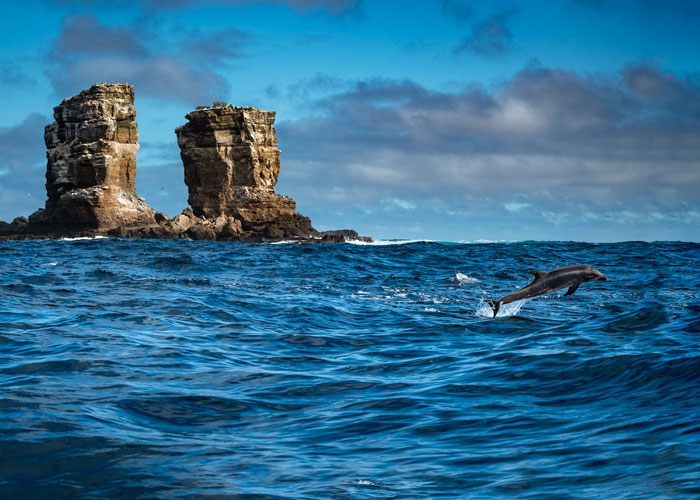

“Our twenty-fifth anniversary next year is a good moment to take stock of how far we have come in protecting the waters around Galápagos, and to identify some of the challenges facing us over the next twenty-five years,” said Ms. Suárez, Head of Marine Ecosystems Research at the Galápagos National Park Directorate. “Back in 1998, the issue of ocean plastics was simply not on the radar here,” explained Dr. Jones, who carried out her Ph.D research on plastics in the region, and who took water samples daily throughout the cruise. “Yet now, we are finding microplastics in some of the remotest and apparently pristine locations of the reserve. This highlights the urgency to identify their source and work to stop them getting into the ocean in the first place.”
Water samples were also taken to identify the cryptic species occurring in the reserve. “As animals move through the water, they shed their DNA, which we can identify from water samples in the laboratory. This helps us discover the hidden diversity of our waters, and therefore, to protect them better” explained Dr. Pazmiño. “We are particularly interested in what species of sharks and rays occur here, and how they are distributed across the reserve, so we are complementing this study by using baited underwater cameras that drift in the water to film and count the animals that approach the bait” added Mr. Armijos. “We can use the numbers to track their distribution and abundance over time.”

Meanwhile on land, Dr. Cárdenas placed devices on endemic flightless cormorants and penguins in the westernmost colonies to track their foraging behavior out at sea. “Most of the behavioral studies for these species have taken place in the sheltered waters between Isabela and Fernandina,” said Dr. Cárdenas. “The westernmost coast of Fernandina is directly exposed to the upwelling from the Cromwell Current and is likely the most vulnerable to changes during El Niño events, which may provide an indication of long term effects of climate change.”


Led by legendary oceanographer Dr. Sylvia Earle, Mission Blue is uniting a global coalition to inspire an upwelling of public awareness, access and support for a worldwide network of marine protected areas – Hope Spots. Under Dr. Earle’s leadership, the Mission Blue team implements communications campaigns that elevate Hope Spots to the world stage through documentaries, social media, traditional media and innovative tools like Google Earth. Mission Blue embarks on regular oceanic expeditions that shed light on these vital ecosystems and build support for their protection. Mission Blue also supports the work of conservation NGOs around the world that share the mission of building public support for ocean protection. The Mission Blue alliance includes more than 200 respected ocean conservation groups and like-minded organizations. https://mission-blue.org
The Galapagos Science Center (GSC), located in Puerto Baquerizo Moreno in San Cristóbal-Galápagos, is a joint initiative between the San Francisco de Quito University (USFQ) and the University of North Carolina at Chapel Hill (UNC) created in 2011. The GSC is a hub to coordinate scientific research projects between local, national, and international scientists to benefit the Galápagos Islands and the world of science. The GSC aims to identify the proper balance between the natural environment and the people who live in and visit the Galápagos. This work requires scientists from different disciplines and the GSC conducts research in more than 13 research areas based on its three fundamental axes: interdisciplinary scientific research, education through science, and community outreach. www.galapagosscience.org
The Galapagos Conservation Trust (GCT) is the only UK registered charity to focus solely on the conservation of the Galapagos Islands, one of the most unique and ecologically important, but vulnerable, areas in the world. With over 25 years of experience supporting impactful conservation programmes across the Archipelago, we partner with Ecuadorian authorities, NGOs, local communities and leading scientists, both in Galapagos and worldwide. By raising funds and awareness in the UK, we are able to support and deliver projects in Galapagos and respond to key threats facing the Islands, focusing on restoring natural habitat, protecting threatened species and driving sustainable solutions, helping to contribute to the overall management of this unique ecosystem. www.galapagosconservation.org.uk
MigraMar was founded in 2006 as a network of scientists dedicated to research and conservation of migratory marine species in the Eastern Pacific. Their mission is to provide the necessary technical advice for the conservation of the migratory marine species in the Eastern Pacific. The network is made up of 22 researchers belonging to universities, government agencies and non-profit organizations in different parts of the American continent. MigraMar provides scientific information regarding migratory patterns of marine species, evaluates and forecasts the state of populations, in order to increase knowledge about these, understand the role they play in the ecosystem, and how best to preserve them. www.migramar.org
The Charles Darwin Foundation for the Galapagos Islands (CDF) is an international non-profit organization dedicated to scientific research. CDF has carried out its mission in the Galapagos since 1959, thanks to an agreement with the Government of Ecuador and with the mandate to pursue and maintain collaborations with government agencies by providing scientific knowledge and technical assistance to promote and secure conservation of Galapagos. http://www.darwinfoundation.org







